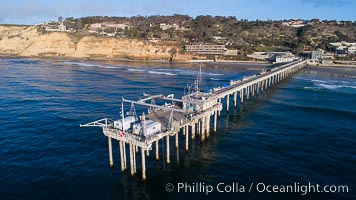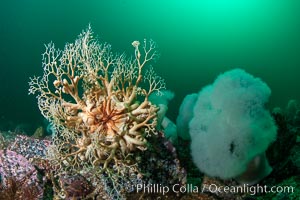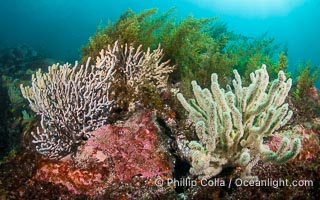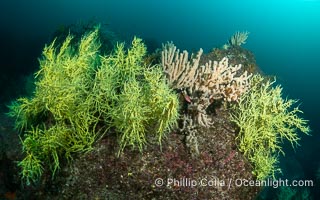
Clouds Rest viewed from Olmsted Point. Clouds Rest is one of the most massive -- if not the singlemost massive -- granite monoliths in the world. A vast lobe of Mesozoic-era granodiorite magma cooled to rock and was gradually uplifted to its present altitude of 9926 ft. Later, glaciers cut it into its present shape.
Location: Yosemite National Park, California
Image ID: 09965
Location: Yosemite National Park, California
Image ID: 09965

Aerial Photo of Scripps Pier. SIO Pier. The Scripps Institution of Oceanography research pier is 1090 feet long and was built of reinforced concrete in 1988, replacing the original wooden pier built in 1915. The Scripps Pier is home to a variety of sensing equipment above and below water that collects various oceanographic data. The Scripps research diving facility is located at the foot of the pier. Fresh seawater is pumped from the pier to the many tanks and facilities of SIO, including the Birch Aquarium. The Scripps Pier is named in honor of Ellen Browning Scripps, the most significant donor and benefactor of the Institution.
Location: Scripps Institution of Oceanography, La Jolla, California
Image ID: 38231
Location: Scripps Institution of Oceanography, La Jolla, California
Image ID: 38231

Truncate Butterflyfish, Chelmonops curiosus, Kangaroo Island, South Australia.
Species: Truncate Butterflyfish, Chelmonops curiosus
Location: Kangaroo Island, South Australia
Image ID: 39221
Species: Truncate Butterflyfish, Chelmonops curiosus
Location: Kangaroo Island, South Australia
Image ID: 39221

Aerial View of the San Rafael Reef, Utah. This is a canyon-like section of the San Rafael Reef, photographed at sunrise. The "reef proper" is on the right, with its characteristic triangular flatiron erosion. The canyon in the center is a fold in the Earth's crust affiliated with the boundary of the San Rafael Swell. The colors seen here arise primarily from Navajo and Wingate sandstone.
Location: Utah
Image ID: 39496
Location: Utah
Image ID: 39496

Milky Way over Arch Rock, planet Venus framed with the arch, at astronomical twilight, Joshua Tree National Park.
Location: Joshua Tree National Park, California
Image ID: 29198
Panorama dimensions: 9335 x 12912
Location: Joshua Tree National Park, California
Image ID: 29198
Panorama dimensions: 9335 x 12912

Galapagos land iguana.
Species: Galapagos land iguana, Conolophus subcristatus
Location: North Seymour Island, Galapagos Islands, Ecuador
Image ID: 16581
Species: Galapagos land iguana, Conolophus subcristatus
Location: North Seymour Island, Galapagos Islands, Ecuador
Image ID: 16581

Parry's Nolina, or Giant Nolina, a flowering plant native to southern California and Arizona founds in deserts and mountains to 6200'. It can reach 6' in height with its flowering inflorescence reaching 12'.
Species: Parry's nolina, Nolina parryi
Location: Joshua Tree National Park, California
Image ID: 26727
Species: Parry's nolina, Nolina parryi
Location: Joshua Tree National Park, California
Image ID: 26727

Desert iguana, one of the most common lizards of the Sonoran and Mojave deserts of the southwestern United States and northwestern Mexico.
Species: Northern desert iguana, Dipsosaurus dorsalis
Location: Joshua Tree National Park, California
Image ID: 26728
Species: Northern desert iguana, Dipsosaurus dorsalis
Location: Joshua Tree National Park, California
Image ID: 26728

Cloud's Rest at sunset, viewed from Olmsted Point. Clouds Rest is one of the most massive -- if not the singlemost massive -- granite monoliths in the world. A vast lobe of Mesozoic-era granodiorite magma cooled to rock and was gradually uplifted to its present altitude of 9926 ft. Later, glaciers cut it into its present shape.
Location: Yosemite National Park, California
Image ID: 25761
Location: Yosemite National Park, California
Image ID: 25761

Arc de Triomphe. The Arc de Triomphe (Arc de Triomphe de l'Etoile) is one of the most famous monuments in Paris. It stands in the centre of the Place Charles de Gaulle (originally named Place de l'Etoile), at the western end of the Champs-Elysees. The Arc de Triomphe (in English: "Triumphal Arch") honors those who fought and died for France in the French Revolutionary and the Napoleonic Wars, with the names of all French victories and generals inscribed on its inner and outer surfaces. Beneath its vault lies the Tomb of the Unknown Soldier from World War I. The monument was designed by Jean Chalgrin in 1806, and its iconographic program pitted heroically nude French youths against bearded Germanic warriors in chain mail. It set the tone for public monuments, with triumphant patriotic messages. The monument stands 50 metres (164 ft) in height, 45 m (148 ft) wide and 22 m (72 ft) deep.
Location: Arc de Triomphe, Paris, France
Image ID: 28084
Location: Arc de Triomphe, Paris, France
Image ID: 28084

Plectorhinchus chaetodonoides, Many-spotted sweetlips, Fiji.
Species: Many spotted sweetlips, Plectorhinchus chaetodonoides
Location: Bligh Waters, Fiji
Image ID: 35021
Species: Many spotted sweetlips, Plectorhinchus chaetodonoides
Location: Bligh Waters, Fiji
Image ID: 35021

Basket Star and Giant Metridium anemone, Browning Pass, Vancouver Island.
Species: Basket star, Giant plumose anemone, Gorgonocephalus eucnemis, Metridium farcimen
Location: British Columbia, Canada
Image ID: 35420
Species: Basket star, Giant plumose anemone, Gorgonocephalus eucnemis, Metridium farcimen
Location: British Columbia, Canada
Image ID: 35420

Basket Star and Giant Metridium anemone, Browning Pass, Vancouver Island.
Species: Basket star, Giant plumose anemone, Gorgonocephalus eucnemis, Metridium farcimen
Location: British Columbia, Canada
Image ID: 35494
Species: Basket star, Giant plumose anemone, Gorgonocephalus eucnemis, Metridium farcimen
Location: British Columbia, Canada
Image ID: 35494

Carlsbad Coast Highway Sunset, North Ponto to Oceanside with Camp Pendleton in the distance. Rising in the distance is San Onofre Mountain (1722') topped by a tall signal tower, one of the southern peaks in the Santa Ana Mountains.
Location: Carlsbad, California
Image ID: 35905
Location: Carlsbad, California
Image ID: 35905

Sunset on Terra Mar and the Carlsbad coastline, looking north to Oceanside, Camp Pendleton and San Onofre. Rising in the distance is San Onofre Mountain (1722') topped by a tall signal tower, one of the southern peaks in the Santa Ana Mountains.
Image ID: 36116
Image ID: 36116

SIO Pier. The Scripps Institution of Oceanography research pier is 1090 feet long and was built of reinforced concrete in 1988, replacing the original wooden pier built in 1915. The Scripps Pier is home to a variety of sensing equipment above and below water that collects various oceanographic data. The Scripps research diving facility is located at the foot of the pier. Fresh seawater is pumped from the pier to the many tanks and facilities of SIO, including the Birch Aquarium. The Scripps Pier is named in honor of Ellen Browning Scripps, the most significant donor and benefactor of the Institution.
Location: Scripps Institution of Oceanography, La Jolla, California
Image ID: 36558
Location: Scripps Institution of Oceanography, La Jolla, California
Image ID: 36558

Gorgonians on Lush Rocky Reef, San Pedro Martir Island, Sea of Cortez. Gorgonians are colonial filter feeders, spreading their branches into the currents flowing over the reef in order to gather passing bits of food.
Location: Isla San Pedro Martir, Sonora, Mexico
Image ID: 40377
Location: Isla San Pedro Martir, Sonora, Mexico
Image ID: 40377

Gorgonians on Lush Rocky Reef, San Pedro Martir Island, Sea of Cortez. Gorgonians are colonial filter feeders, spreading their branches into the currents flowing over the reef in order to gather passing bits of food.
Location: Isla San Pedro Martir, Sonora, Mexico
Image ID: 40385
Location: Isla San Pedro Martir, Sonora, Mexico
Image ID: 40385

Gorgonians on Lush Rocky Reef, San Pedro Martir Island, Sea of Cortez. Gorgonians are colonial filter feeders, spreading their branches into the currents flowing over the reef in order to gather passing bits of food.
Location: Isla San Pedro Martir, Sonora, Mexico
Image ID: 40387
Location: Isla San Pedro Martir, Sonora, Mexico
Image ID: 40387

Black Coral and Gorgonians on Rocky Reef, San Pedro Martir Island, Mexico.
Location: Isla San Pedro Martir, Sonora, Mexico
Image ID: 40390
Location: Isla San Pedro Martir, Sonora, Mexico
Image ID: 40390

Black Coral and Gorgonians on Rocky Reef, San Pedro Martir Island, Mexico.
Location: Isla San Pedro Martir, Sonora, Mexico
Image ID: 40392
Location: Isla San Pedro Martir, Sonora, Mexico
Image ID: 40392

Pink Sponges Encrusting Rocky Reef alongside various species of algae and gorgonians, San Pedro Martir Island, Sea of Cortez.
Location: Isla San Pedro Martir, Sonora, Mexico
Image ID: 40417
Location: Isla San Pedro Martir, Sonora, Mexico
Image ID: 40417

Milky Way at Night over Arch Rock, Joshua Tree National Park.
Location: Joshua Tree National Park, California
Image ID: 29197
Panorama dimensions: 7596 x 12603
Location: Joshua Tree National Park, California
Image ID: 29197
Panorama dimensions: 7596 x 12603

Milky Way over Arch Rock, planet Venus framed with the arch, at astronomical twilight, Joshua Tree National Park.
Location: Joshua Tree National Park, California
Image ID: 29199
Panorama dimensions: 8724 x 11400
Location: Joshua Tree National Park, California
Image ID: 29199
Panorama dimensions: 8724 x 11400

Lunar Eclipse and blood red moon sequence, stars, astronomical twilight, composite image, Joshua Tree National Park, April 14/15 2014.
Location: Joshua Tree National Park, California
Image ID: 29202
Location: Joshua Tree National Park, California
Image ID: 29202

Palomar Observatory at sunset.
Location: Palomar Observatory, Palomar Mountain, California
Image ID: 29331
Location: Palomar Observatory, Palomar Mountain, California
Image ID: 29331

Palomar Observatory at sunset.
Location: Palomar Observatory, Palomar Mountain, California
Image ID: 29332
Location: Palomar Observatory, Palomar Mountain, California
Image ID: 29332


